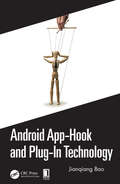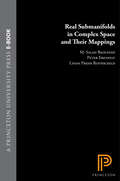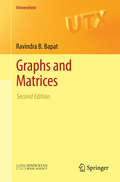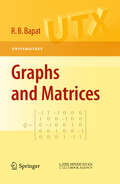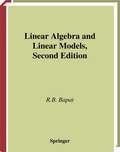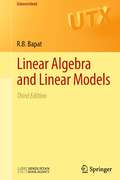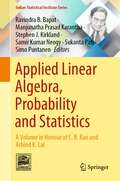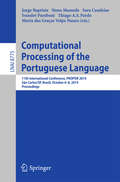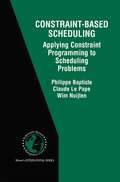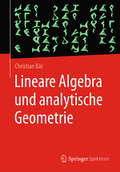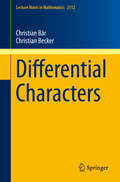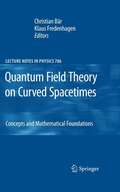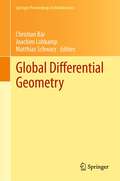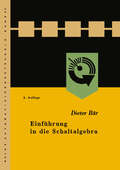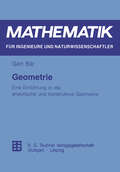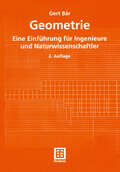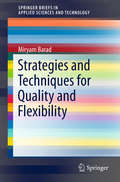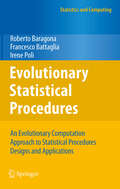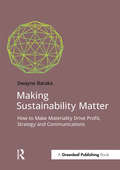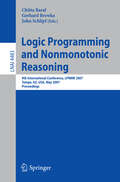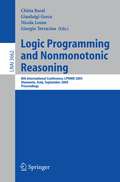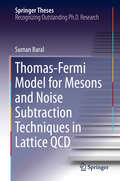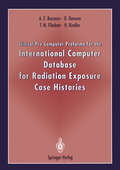- Table View
- List View
Android App-Hook and Plug-In Technology
by Jianqiang BaoThis book presents the Android plug-in technology used in Android development. This technology is widely used by a majority of Chinese internet companies, and is becoming more widely used worldwide. The book fully describes the history of Android plug-in technology, the installation and startup process, and new features of the Android plug-in technology. It also explores plug-in solutions for peripheral technologies. The book is designed to help Android app developers better understand the underlying technology of the Android system. Features Introduces Android system knowledge, including the communication between AMS and four components Describes the Hook technique by Proxy.newProxyInstance and reflection, to modify Android system behavior, for example, to launch an activity not declared in the AndroidManifest. Shows how to use the Hook apk packaging process in Gradle Covers how to merge the resources in the plugin app and the host app, and how to merge dex of the host app and all the plugin apps Presents the SO technique and how to launch SO files dynamically
Android App-Hook and Plug-In Technology
by Jianqiang BaoThis book presents the Android plug-in technology used in Android development. This technology is widely used by a majority of Chinese internet companies, and is becoming more widely used worldwide. The book fully describes the history of Android plug-in technology, the installation and startup process, and new features of the Android plug-in technology. It also explores plug-in solutions for peripheral technologies. The book is designed to help Android app developers better understand the underlying technology of the Android system. Features Introduces Android system knowledge, including the communication between AMS and four components Describes the Hook technique by Proxy.newProxyInstance and reflection, to modify Android system behavior, for example, to launch an activity not declared in the AndroidManifest. Shows how to use the Hook apk packaging process in Gradle Covers how to merge the resources in the plugin app and the host app, and how to merge dex of the host app and all the plugin apps Presents the SO technique and how to launch SO files dynamically
Real Submanifolds in Complex Space and Their Mappings (PMS-47)
by M. Salah Baouendi Peter Ebenfelt Linda Preiss RothschildThis book presents many of the main developments of the past two decades in the study of real submanifolds in complex space, providing crucial background material for researchers and advanced graduate students. The techniques in this area borrow from real and complex analysis and partial differential equations, as well as from differential, algebraic, and analytical geometry. In turn, these latter areas have been enriched over the years by the study of problems in several complex variables addressed here. The authors, M. Salah Baouendi, Peter Ebenfelt, and Linda Preiss Rothschild, include extensive preliminary material to make the book accessible to nonspecialists. One of the most important topics that the authors address here is the holomorphic extension of functions and mappings that satisfy the tangential Cauchy-Riemann equations on real submanifolds. They present the main results in this area with a novel and self-contained approach. The book also devotes considerable attention to the study of holomorphic mappings between real submanifolds, and proves finite determination of such mappings by their jets under some optimal assumptions. The authors also give a thorough comparison of the various nondegeneracy conditions for manifolds and mappings and present new geometric interpretations of these conditions. Throughout the book, Cauchy-Riemann vector fields and their orbits play a central role and are presented in a setting that is both general and elementary.
Graphs and Matrices (Universitext)
by Ravindra B. BapatThis new edition illustrates the power of linear algebra in the study of graphs. The emphasis on matrix techniques is greater than in other texts on algebraic graph theory. Important matrices associated with graphs (for example, incidence, adjacency and Laplacian matrices) are treated in detail.Presenting a useful overview of selected topics in algebraic graph theory, early chapters of the text focus on regular graphs, algebraic connectivity, the distance matrix of a tree, and its generalized version for arbitrary graphs, known as the resistance matrix. Coverage of later topics include Laplacian eigenvalues of threshold graphs, the positive definite completion problem and matrix games based on a graph.Such an extensive coverage of the subject area provides a welcome prompt for further exploration. The inclusion of exercises enables practical learning throughout the book.In the new edition, a new chapter is added on the line graph of a tree, while some results in Chapter 6 on Perron-Frobenius theory are reorganized.Whilst this book will be invaluable to students and researchers in graph theory and combinatorial matrix theory, it will also benefit readers in the sciences and engineering.
Graphs and Matrices (Universitext)
by Ravindra B. BapatGraphs and Matrices provides a welcome addition to the rapidly expanding selection of literature in this field. As the title suggests, the book’s primary focus is graph theory, with an emphasis on topics relating to linear algebra and matrix theory. Information is presented at a relatively elementary level with the view of leading the student into further research. In the first part of the book matrix preliminaries are discussed and the basic properties of graph-associated matrices highlighted. Further topics include those of graph theory such as regular graphs and algebraic connectivity, Laplacian eigenvalues of threshold graphs, positive definite completion problem and graph-based matrix games. Whilst this book will be invaluable to researchers in graph theory, it may also be of benefit to a wider, cross-disciplinary readership.
Linear Algebra and Linear Models (Universitext)
by Ravindra B. BapatThis book provides a rigorous introduction to the basic aspects of the theory of linear estimation and hypothesis testing, covering the necessary prerequisites in matrices, multivariate normal distribution and distributions of quadratic forms along the way. It will appeal to advanced undergraduate and first-year graduate students, research mathematicians and statisticians.
Linear Algebra and Linear Models (Universitext)
by Ravindra B. BapatLinear Algebra and Linear Models comprises a concise and rigorous introduction to linear algebra required for statistics followed by the basic aspects of the theory of linear estimation and hypothesis testing. The emphasis is on the approach using generalized inverses. Topics such as the multivariate normal distribution and distribution of quadratic forms are included.For this third edition, the material has been reorganised to develop the linear algebra in the first six chapters, to serve as a first course on linear algebra that is especially suitable for students of statistics or for those looking for a matrix theoretic approach to the subject. Other key features include: coverage of topics such as rank additivity, inequalities for eigenvalues and singular values; a new chapter on linear mixed models; over seventy additional problems on rank: the matrix rank is an important and rich topic with connections to many aspects of linear algebra such as generalized inverses, idempotent matrices and partitioned matrices.This text is aimed primarily at advanced undergraduate and first-year graduate students taking courses in linear algebra, linear models, multivariate analysis and design of experiments. A wealth of exercises, complete with hints and solutions, help to consolidate understanding. Researchers in mathematics and statistics will also find the book a useful source of results and problems.
Applied Linear Algebra, Probability and Statistics: A Volume in Honour of C. R. Rao and Arbind K. Lal (Indian Statistical Institute Series)
by Ravindra B. Bapat Manjunatha Prasad Karantha Stephen J. Kirkland Samir Kumar Neogy Sukanta Pati Simo PuntanenThis book focuses on research in linear algebra, statistics, matrices, graphs and their applications. Many chapters in the book feature new findings due to applications of matrix and graph methods. The book also discusses rediscoveries of the subject by using new methods. Dedicated to Prof. Calyampudi Radhakrishna Rao (C.R. Rao) who has completed 100 years of legendary life and continues to inspire us all and Prof. Arbind K. Lal who has sadly departed us too early, it has contributions from collaborators, students, colleagues and admirers of Professors Rao and Lal. With many chapters on generalized inverses, matrix analysis, matrices and graphs, applied probability and statistics, and the history of ancient mathematics, this book offers a diverse array of mathematical results, techniques and applications. The book promises to be especially rewarding for readers with an interest in the focus areas of applied linear algebra, probability and statistics.
Computational Processing of the Portuguese Language: 11th International Conference, PROPOR 2014, Sao Carlos/SP, Brazil, October 6-8, 2014, Proceedings (Lecture Notes in Computer Science #8775)
by Jorge Baptista Nuno Mamede Sara Candeias Ivandré Paraboni Thiago A. S. Pardo Maria Das Gracas Volpe NunesThis book constitutes the refereed proceedings of the 11th International Workshop on Computational Processing of the Portuguese Language, PROPOR 2014, held in Sao Carlos, Brazil, in October 2014. The 14 full papers and 19 short papers presented in this volume were carefully reviewed and selected from 63 submissions. The papers are organized in topical sections named: speech language processing and applications; linguistic description, syntax and parsing; ontologies, semantics and lexicography; corpora and language resources and natural language processing, tools and applications.
Constraint-Based Scheduling: Applying Constraint Programming to Scheduling Problems (International Series in Operations Research & Management Science #39)
by Philippe Baptiste Claude Le Pape Wim NuijtenConstraint Programming is a problem-solving paradigm that establishes a clear distinction between two pivotal aspects of a problem: (1) a precise definition of the constraints that define the problem to be solved and (2) the algorithms and heuristics enabling the selection of decisions to solve the problem. It is because of these capabilities that Constraint Programming is increasingly being employed as a problem-solving tool to solve scheduling problems. Hence the development of Constraint-Based Scheduling as a field of study. The aim of this book is to provide an overview of the most widely used Constraint-Based Scheduling techniques. Following the principles of Constraint Programming, the book consists of three distinct parts: The first chapter introduces the basic principles of Constraint Programming and provides a model of the constraints that are the most often encountered in scheduling problems. Chapters 2, 3, 4, and 5 are focused on the propagation of resource constraints, which usually are responsible for the "hardness" of the scheduling problem. Chapters 6, 7, and 8 are dedicated to the resolution of several scheduling problems. These examples illustrate the use and the practical efficiency of the constraint propagation methods of the previous chapters. They also show that besides constraint propagation, the exploration of the search space must be carefully designed, taking into account specific properties of the considered problem (e.g., dominance relations, symmetries, possible use of decomposition rules). Chapter 9 mentions various extensions of the model and presents promising research directions.
Lineare Algebra und analytische Geometrie
by Christian BärDas Werk bietet eine Einführung in die lineare Algebra und die analytische Geometrie und enthält Material für eine zweisemestrige Vorlesung. Es beginnt mit einem Kapitel, das allgemein in die mathematische Denkweise und Beweistechniken einführt, um dann über lineare Gleichungssysteme zur linearen Algebra überzuleiten. Besonderer Wert wird auf eine enge Verzahnung von algebraischen und geometrischen Konzepten gelegt, zum einen um eine gute geometrische Intuition für algebraische Begriffe zu entwickeln, zum anderen um elegante algebraische Beweismethoden für geometrische Sätze einsetzen zu können. Der Text ist klar und verständlich geschrieben und in einem erfrischenden Stil verfasst. Schließlich sind interaktive Übungsseiten und Illustrationen integriert, die zu einem aktiven Studium anregen.
Differential Characters (Lecture Notes in Mathematics #2112)
by Christian Bär Christian BeckerProviding a systematic introduction to differential characters as introduced by Cheeger and Simons, this text describes important concepts such as fiber integration, higher dimensional holonomy, transgression, and the product structure in a geometric manner. Differential characters form a model of what is nowadays called differential cohomology, which is the mathematical structure behind the higher gauge theories in physics.
Quantum Field Theory on Curved Spacetimes: Concepts and Mathematical Foundations (Lecture Notes in Physics #786)
by Christian Bär Klaus FredenhagenAfter some decades of work a satisfactory theory of quantum gravity is still not available; moreover, there are indications that the original field theoretical approach may be better suited than originally expected. There, to first approximation, one is left with the problem of quantum field theory on Lorentzian manifolds. Surprisingly, this seemingly modest approach leads to far reaching conceptual and mathematical problems and to spectacular predictions, the most famous one being the Hawking radiation of black holes. Ingredients of this approach are the formulation of quantum physics in terms of C*-algebras, the geometry of Lorentzian manifolds, in particular their causal structure, and linear hyperbolic differential equations where the well-posedness of the Cauchy problem plays a distinguished role, as well as more recently the insights from suitable concepts such as microlocal analysis. This primer is an outgrowth of a compact course given by the editors and contributing authors to an audience of advanced graduate students and young researchers in the field, and assumes working knowledge of differential geometry and functional analysis on the part of the reader.
Global Differential Geometry (Springer Proceedings in Mathematics #17)
by Christian Bär Joachim Lohkamp Matthias SchwarzThis volume contains a collection of well-written surveys provided by experts in Global Differential Geometry to give an overview over recent developments in Riemannian Geometry, Geometric Analysis and Symplectic Geometry.The papers are written for graduate students and researchers with a general interest in geometry, who want to get acquainted with the current trends in these central fields of modern mathematics.
Geometrie: Eine Einführung in die analytische und konstruktive Geometrie (Mathematik für Ingenieure und Naturwissenschaftler, Ökonomen und Landwirte)
by Gert BärGeometrie: Eine Einführung für Ingenieure und Naturwissenschaftler (Mathematik für Ingenieure und Naturwissenschaftler, Ökonomen und Landwirte)
by Gert BärDieses Lehrbuch knüpft bei den Schulkenntnissen an und hilft, vielfältige geometrische Formen und Vorgänge zu verstehen, zu gestalten, zu zeichnen und zu berechnen. In kurzer und prägnanter Darstellung enthält dieses Lehrbuch alles was Ingenieur-Studenten über Geometrie wissen sollten. Beispiele und Aufgaben erleichtern das Verständnis und bieten die Möglichkeit zur Selbstkontrolle.
Strategies and Techniques for Quality and Flexibility (SpringerBriefs in Applied Sciences and Technology)
by Miryam BaradThis book presents strategic perspectives on quality and flexibility, as well as quantitative tools for assessing their implementation in a range of systems. It introduces readers to the global changes in the relative importance of quality strategies and flexibility strategies over the past 30 to 40 years. In addition, it presents detailed examples of how multi-purpose techniques such as design of experiments, petri nets and quality function deployment can be applied to evaluate quality and flexibility in the design, planning and operation of various systems. Uniquely, the book combines strategies and quantitative research tools in a single volume. It also includes many examples that are accessible to readers from different disciplines, and familiarizes readers with techniques that can facilitate their current and future research – making it a valuable resource for researchers, practitioners and advanced students alike.
Evolutionary Statistical Procedures: An Evolutionary Computation Approach to Statistical Procedures Designs and Applications (Statistics and Computing)
by Roberto Baragona Francesco Battaglia Irene PoliThis proposed text appears to be a good introduction to evolutionary computation for use in applied statistics research. The authors draw from a vast base of knowledge about the current literature in both the design of evolutionary algorithms and statistical techniques. Modern statistical research is on the threshold of solving increasingly complex problems in high dimensions, and the generalization of its methodology to parameters whose estimators do not follow mathematically simple distributions is underway. Many of these challenges involve optimizing functions for which analytic solutions are infeasible. Evolutionary algorithms represent a powerful and easily understood means of approximating the optimum value in a variety of settings. The proposed text seeks to guide readers through the crucial issues of optimization problems in statistical settings and the implementation of tailored methods (including both stand-alone evolutionary algorithms and hybrid crosses of these procedures with standard statistical algorithms like Metropolis-Hastings) in a variety of applications. This book would serve as an excellent reference work for statistical researchers at an advanced graduate level or beyond, particularly those with a strong background in computer science.
Making Sustainability Matter: How to Make Materiality Drive Profit, Strategy and Communications
by Dwayne BarakaMateriality is the lynch-pin that can align your sustainability initiatives with your organizational strategy – and form the basis of communications and reports that generate trust and transparency. What's more, most companies could be significantly more profitable by engaging with their most material sustainability issues. Making Sustainability Matter, by business strategy expert Dwayne Baraka, draws lessons from the author's work with a wide range of organizations, including several of the FTSE 100, financial services, housing associations and technology companies. It will show you how to: identify your organization's most material sustainability issues, and use a well thought out materiality process to integrate sustainability into your organization; allocate resources to sustainability initiatives for optimal returns – and avoid wasting resources on programmes that are not strategically aligned to your business; connect your communications to materiality, and; clarify which issues are important to your stakeholders. Case studies from SAP and Marks and Spencer are included along with appendices on common material sustainability issues, sustainability issues record and further resources.
Logic Programming and Nonmonotonic Reasoning: 9th International Conference, LPNMR 2007, Tempe, AZ, USA, May 15-17, 2007, Proceedings (Lecture Notes in Computer Science #4483)
by Chitta Baral Gerhard Brewka John SchlipfThis book constitutes the refereed proceedings of the 9th International Conference on Logic Programming and Nonmonotonic Reasoning, LPNMR 2007, held in Tempe, AZ, USA, May 2007. This conference encompasses theoretical studies, design and implementation of logic based programming languages and database systems, and development of experimental systems.
Logic Programming and Nonmonotonic Reasoning: 8th International Conference, LPNMR 2005, Diamante, Italy, September 5-8, 2005, Proceedings (Lecture Notes in Computer Science #3662)
by Chitta Baral Gianluigi Greco Nicola Leone Giorgio TerracinaThomas-Fermi Model for Mesons and Noise Subtraction Techniques in Lattice QCD (Springer Theses)
by Suman BaralThis thesis make significant contributions to both the numerical and analytical aspects of particle physics, reducing the noise associated with matrix calculations in quantum chromodynamics (QCD) and modeling multi-quark mesonic matters that could be used to investigate particles previously unseen in nature. Several methods are developed that can reduce the statistical uncertainty in the extraction of hard-to-detect lattice QCD signals from disconnected diagrams. The most promising technique beats competing methods by 1700 percent, leading to a potential decrease in the computation time of quark loop quantities by an order of magnitude. This not only increases efficiency but also works for QCD matrices with almost-zero eigenvalues, a region where most QCD algorithms break down. This thesis also develops analytical solutions used to investigate exotic particles, specifically the Thomas-Fermi quark model, giving insight into possible new states formed from mesonic matter. The main benefit of this model is that it can work for a large number of quarks which is currently almost impossible with lattice QCD. Patterns of single-quark energies are observed which give the first a priori indication that stable octa-quark and hexadeca-quark versions of the charmed and bottom Z-meson exist.
Clinical Pre Computer Proforma for the International Computer Database for Radiation Exposure Case Histories
by Alexander E. Baranov Dirk Densow T.M. Fliedner Hauke KindlerThis publication provides guidance on preparing data to be input into an international computerised database for clinical case histories of persons accidentally exposed to whole body irradiation. The publication has resulted from a close collaboration between the Institute of Biophysics including its Hospital Number 6 in Moscow, Russia, and the Institute of Occupational and Social Medicine at the University of Ulm. In both institutions, much experience has been accumulated during the last 20 years in dealing with basic and clinical research in the field of radiation accident management. In both institutions many case histories of radiation accident victims have been recorded. On this basis the scientists and clinicians from both institutions developed, over the last two years, a pre computer proforma to feed the International Computer Database for Radiation Exposure Case Histories, with standardised data from clinical case histories of radiation accident victims. This activity should be seen as part of WHO efforts to establish a network of institutions around the world, competent in Radiation Emergency Medical Preparedness and Assistance. This network has become known as REMPAN and it is prepared to provide medical advice and assistance when a radiation accident occurs in any country. The Institute of Occupational and Social Medicine, at the University of Ulm, is part of this global network.
50 Years with Hardy Spaces: A Tribute to Victor Havin (Operator Theory: Advances and Applications #261)
by Anton Baranov Sergei Kisliakov Nikolai NikolskiWritten in honor of Victor Havin (1933–2015), this volume presents a collection of surveys and original papers on harmonic and complex analysis, function spaces and related topics, authored by internationally recognized experts in the fields. It also features an illustrated scientific biography of Victor Havin, one of the leading analysts of the second half of the 20th century and founder of the Saint Petersburg Analysis Seminar. A complete list of his publications, as well as his public speech "Mathematics as a source of certainty and uncertainty", presented at the Doctor Honoris Causa ceremony at Linköping University, are also included.
